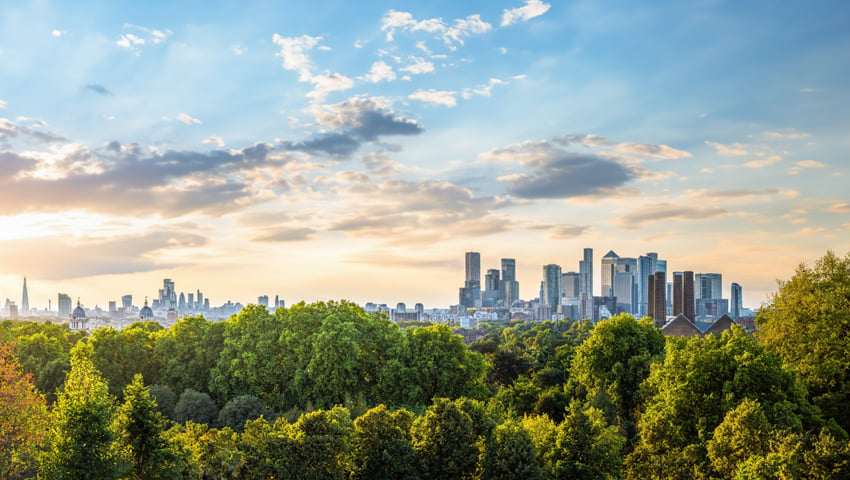The London Climate Resilience Review has found that London’s trees, and other green and blue spaces, are under threat from heatwaves, wildfires and windstorms. These impacts will severely weaken London’s resilience because trees reduce street temperatures in heatwaves and decrease flood risk.
The London Climate Resilience Review has published its full and final report into London’s preparedness for climate impacts including heatwaves, floods, droughts, wildfires, storms, sea level rise and subsidence.
The Mayor of London called for the Review after parts of London received more than twice the average July rainfall in 2021, and Londoners died in 2022’s 40°C heatwave.
Alongside immediate dangers to people’s lives and livelihoods the Review found that government and businesses have not adequately planned for the disruption caused when severe weather impacts “cascade” through critical systems like healthcare, transport, energy and water.
The London Climate Resilience Review found:
- Climate impacts in London happen together. The 40°C heatwave occurred at the same time as drought and wildfires, and heatwaves are often followed by flash flooding.
- London’s trees, and other green and blue spaces, are under threat from heatwaves, wildfires and windstorms. This weakens London’s resilience because trees reduce street temperatures in heatwaves and decrease flood risk.
- The new government’s plans to build more homes and better infrastructure must include updating resilience and technical standards to cope with the weather extremes London can expect in the coming decades.
- The UK’s ageing population, and particularly older people over 65 in care homes, are at the highest risk of heat-related mortality.
- London and the whole of the south-east of England needs a new reservoir.
- The UK government should produce a National Wildfire Strategy and Action Plan by the end of 2025. That Strategy must reflect the increased risk of reduced water supply due to drought and therefore consider non-water-based fire suppression methods.
- The deadline for upgrading flood defences upstream of the Thames Barrier is 2050, and downstream it is 2040; a new Barrier is needed by 2070.
- Around 43% of London properties are likely to be affected by subsidence by 2030.
- Based on the work of the London Surface Water Strategic Group, UK government should create a Strategic Surface Water Authority for London, led by an independent and non-political Chair, to promote, enforce, and allocate funds in-line with a strategic London-wide approach to flooding.
- Initial analysis indicates climate change could impact London’s GDP by 2-3% every year by the 2050s, with costs increasing further in late century.
The publication of the Review comes days after the general election, during which the Labour manifesto pledged to improve climate resilience and preparation at a national and local level.
Emma Howard Boyd CBE, Chair of the London Climate Resilience Review, said, “We are entering a new era. In 2024, even as El Niño fades, we are set for another record-breaking year of deadly heatwaves, wildfires and storms. In the last year, floods in the UK have upended lives and battered local economies.
“The Mayor of London took a world-leading step by calling for an independent review of London’s climate resilience. The health and security of Londoners and the health of the national economy are inseparable.
“This is a reset moment for efforts to increase the UK’s stability in the face of global climate disruption. As the new government takes action to end the cost-of-living crisis, protecting the lives and livelihoods of working people from extreme weather is non-negotiable.”
In 2022, the Mayor established the £3.1m Trees for London programme with the aim of increasing London’s resilience to extreme weather of the type experienced that summer. In the first two years the programme has funded the planting of more than 115,000 trees prioritising areas of high heat and flood risk. To maintain this momentum in its final year, the Mayor has awarded the Trees for London Programme an additional £1m to help make London a fairer, greener more resilient city.
Mayor of London Sadiq Khan said, “Climate change is one of the biggest dangers our capital faces, and its effects cannot be ignored.
“I welcome this review, which I commissioned after seeing first-hand during recent years how extreme weather can devastate communities, ruin businesses and end lives. It is essential that we invest in key sectors and prepare our public services so that London can continue to grow and thrive in the face of climate change, and the review provides clarity and direction on how to do this. This is also an issue of social justice as the review makes clear it is Londoners on lower incomes that are most exposed to the impacts of dangerous climate change.
“I accept the recommendations made to City Hall, and we will work to take forward the recommendations over the coming months, working with our new national Government, local councils, businesses and London’s communities We do not have a moment to waste.”
The Review gathered evidence from individuals, communities and organisations including the NHS, Transport for London, London Fire Brigade, the Metropolitan Police, Borough Councils, the GLA, UK government, NGOs, the financial services sector, sports and cultural institutions as well as representatives of vulnerable groups.
The final report is available here
